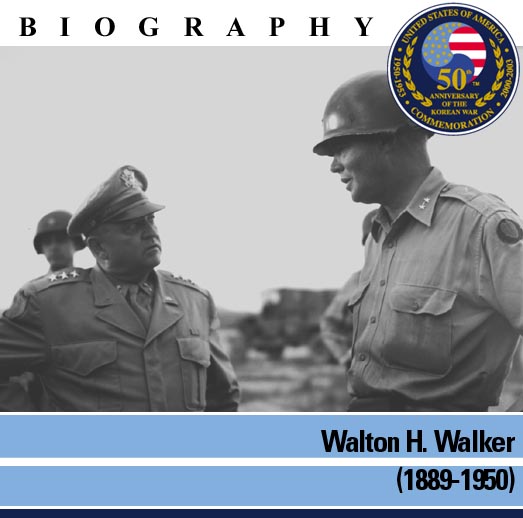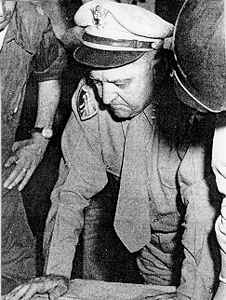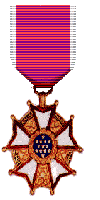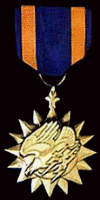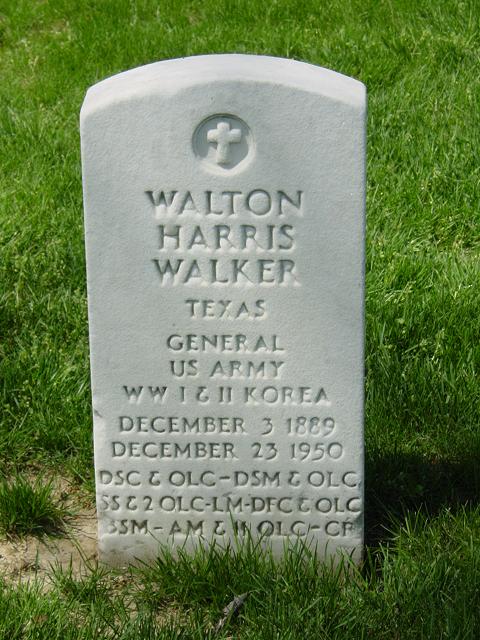Born on December 3, 1889, he graduated from West Point in 1912.
He served under General Frederick Funston in the Vera Cruz Expedition in 1914 and then on the border patrol near Mexico during the period before World War I. In 1917, he organized Company A, 13th Machinegun Battalion and went with it to France. In April 1917, as a Major, he led the Battalion at St. Mihiel and in the Meuse-Argonne, where he was twice cited for gallantry and where he was promoted to Lieutenant Colonel on the battlefield.
In World War II, he commanded the 3rd Armored Division and then the IV Armored orps in 1941. In 1943, IV Corps was designated XX Corps and he led it for the rest of the war. He was promoted to Lieutenant General in 1945, with the very same stars which George S. Patton, Jr. had received from General Dwight D. Eisenhower on his own promotion. He was a tough commander, not given to sentiment, reticent of manner, short of speech in any public appearances and was not popular with his troops. During the war, he took part in the drive across France following the Normandy Invasion, the capture of Metz and the liberation of Buchenwald.
During the Korean War he performed ably and his defense of the Naktong Line is regarded as a military classic. He was comander of the 8th Army in Korea when he was killed in the wreck of his jeep. His body was escorted back to the United States by his son, Sam Sims Walker, a battalion commander in the 19th Infantry in Korea at the time of his father’s death. He was buried in Section 34 of Arlington National Cemetery. His wife, Caroline E. Walker (May 16, 1897-March 31, 1985), is buried with him.
During his career, he was the recipient of the Distinguished Service Cross, with Oak Leaf Cluster; the Distinguished Service Medal, with Oak Leaf Cluster; the Silver Star, with two Oak Leaf Clusters; the Legion of Merit; the Distinguished Flying Cross; the Air Medal, with Oak Leaf Cluster.
Courtesy of the Center For Military History, United States Army
Born at Belton, Texas, December 3, 1889. General, US Army; Non-hostile Death. Died December 23, 1950 in Korea. USMA Class of 1912, General Walker was a highly decorated veteran of World War I and World War II.
In Korea he commanded 8th Army until his death in an automobile accident on December 23, 1950. For his leadership and valor, General Walker was awarded the Distinguished Service Cross with Oak Leaf Cluster, the Distinguished Service Medal with Oak Leaf Cluster, the Silver Star with 2 Oak Leaf Clusters, the Legion of Merit, the Bronze Star and the Commendation Ribbon.
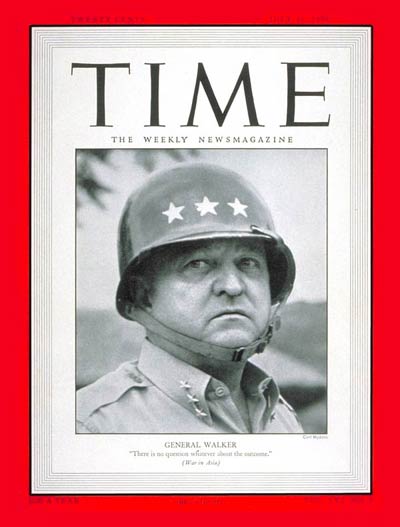
General Walton Harris Walker was the commander of the Eighth Army in the early part of the Korean War conflict and successfully conducted the defense of the Pusan Perimeter. A native of Belton, Texas, Walker entered Virginia Military Institute (VMI) in 1907 and later transferred to the U.S. Military Academy at West Point, graduating in 1912. He was awarded the Silver Star medal for bravery in action during World War I.
During the interim war years Walker held a variety of assignments. In 1924, he married Caroline Victoria Emerson of Baltimore and they had a son, Sam Sims, who graduated from West Point in 1946. Walton Walker excelled in the training of troops and held a number of progressive training positions prior to World War II. He also had picked up the nickname of “Johnnie Walker,” derived from a brand of scotch whiskey he favored. He assumed command of the 3rd Armored Division in early 1942. During World War II he was a protege of General George S. Patton and rose to the rank of lieutenant general (brevet). Walker was also awarded the Distinguished Service Cross, the Army’s second highest award for valor. He was well respected by Patton and he developed a reputation as a tough leader and fighter.
After World War II he filled several assignments before taking command of the Eighth Army, which was performing occupation duty in Japan. There he obtained his permanent promotion to major general. The Eighth Army was composed of four divisions, the 1st Cavalry, 7th, 24th, and 25th Infantry Divisions. The combat readiness of the Eighth Army had declined due to congressionally imposed postwar budget and personnel cuts. The troops were largely undertrained, lacked sufficient equipment, and had grown soft with the relaxed pace of their occupation duty. Only 10 percent of the soldiers had combat experience. Despite the cuts, which were largely beyond his control, Walker instituted a massive training program toward the latter part of 1949 to upgrade the combat readiness of the Eighth Army. Unfortunately, the training exercises and programs were too late to adequately prepare the occupation forces with the combat skills they would desperately need in the coming months.
The Korean War broke out on June 25, 1950, with a massive multi-front attack by the North Korean Army across the 38th parallel, an artificial border which divided North and South Korea. On June 30, General Walker received his battle orders formally committing his forces to the Korean conflict. On July 13, Walker was placed in charge of all U.S. Army forces in Korea, and four days later was also put in charge of all South Korean forces. General Walker’s initial orders were to engage the North Korean Army as far north as possible and defeat them. It was commonly thought that the North Koreans would turn and run once they ran into American soldiers. Walker, on the contrary, was under no illusions about the capabilities of the Eighth Army. However, he had already run afoul of his superior, General Douglas MacArthur, and was in no position to question the orders he had received.
By July, with the fall of Taejon, it was apparent to General Walker that the Eighth Army would be forced to pull back even further. He feared for the safety of his own command post in Taegu, the nerve center of the perimeter defense. By late July his forces equaled in numbers the invading North Korean Army, although many of his troops were engaged in supply and support roles. However, the quality of the Allied forces remained deficient and the North Koreans held the initiative. Walker had the unenviable task of conducting a delaying action with his Eighth Army until sufficient forces could be built up to launch a counteroffensive into the North Korean Army’s rear area. By now his perimeter had shrunk to an area roughly fifty miles wide by one hundred miles in length from north to south. This became known as the “Pusan Perimeter.”
One critical advantage General Walker possessed was that his military intelligence assets had broken the North Korean radio codes. Thus Walker knew every major North Korean movement prior to its occurrence. He had his major units deployed on the front lines, yet kept a mobile reserve that could be rushed in to plug any local breakthrough. His ability to read the enemy’s radio traffic enabled Walker to rush reinforcements to where they were needed on short notice. Often Walker could be found at the front line personally appraising the battle situation and issuing orders to local commanders. He told one commander that he only wanted to see him behind the lines in his coffin!
After numerous battle debacles and more than a hundred miles of retreating, the Eighth Army’s morale was low. During a conference in Taegu with General MacArthur, it was determined that there could no longer be any retreating by the Eighth Army. Shortly after the meeting, on July 29, General Walker issued his famed “Stand or Die” order to the beleaguered defenders of the Pusan Perimeter. This command was timely, for an all-out North Korean offensive was launched against the perimeter in five different spots on September 1. General Walker’s use of Marines and U.S. Army troops as a fire brigade to contain any North Korean breakthrough proved to be a sound strategy, and forestalled a forced withdrawal from the Korean peninsula.
General Walker’s holding mission was part of the overall strategy of General MacArthur. MacArthur’s plan was to launch a flanking attack deep behind enemy lines at the port of Inchon. The Inchon landing took place on September 15. General Walker planned his own breakout attack from the perimeter for September 16. By that time Walker felt that the North Korean forces would be demoralized with the knowledge that the landings had effectively cut off their lines of supply and retreat. Unfortunately for Walker, the North Korean soldiers had not heard of the Inchon landing and instead launched their own attack, which stalled the American breakout attempt in the Waegwan area. To top it off, the weather was overcast, preventing the use of close air support. Ultimately, the North Korean resistance began to crumble and the weather cleared, which allowed the employment of air assets. General Walker’s forces gained the initiative on the northern, north western, and western fronts with successive assaults against the crumbling North Korean Army. While the South Korean Army led the attack up the eastern seaboard, the 1st Cavalry Division and others attacked up the main highway leading roughly northwest toward Taejon and recaptured the city. On September 27 the linkup with the 7th Division which had landed at Inchon was completed just north of Osan, approximately twenty miles south of Seoul. Of the approximately 100,000 North Korean soldiers surrounding the Pusan Perimeter only 25,000 to 30,000 are believed to have ever made it back to North Korea.
General Walker continued leading the Eighth Army in its attack across the 38th Parallel into North Korea. The capture of the North Korean capital of Pyongyang was completed on October 20. On October 24, General Walker established his advance headquarters in North Korean Premier Kim Il Sung’s abandoned headquarters building. As the Eighth Army moved north there arose a dispute between political and military forces in Washington, which wanted to limit the war, and General MacArthur, who wanted to carry the attack to complete victory.
In October 1950, Chinese soldiers were encountered for the first time north of Unsan in North Korea. Despite mounting evidence of increasing resistance, General MacArthur hinted that American troops would begin returning home by Christmas, much to the consternation of General Walker. This belief of an early victory was so widespread that several United Nations members held back some of the troops they had earmarked for the Korean campaign.
This optimistic view would change quickly as the situation on the northern front lines rapidly deteriorated. In a series of vicious firefights the Eighth Army was stalled in its tracks and put on the defensive. MacArthur optimistically (or perhaps naively) ordered General Walker to press on with the attack toward the Yalu River despite the increasingly hostile weather, numerous supply shortages, and evidence of massive Chinese intervention.
Walker was reluctant to blindly press on with the attack at this point of the war, notwithstanding his past association with George S. Patton. He increasingly feared Chinese intervention and he had no illusions of a quick victory. Walker prudently delayed resuming the offensive while he tried to replace his personnel losses and build up his logistical supplies. He expressed fear of being forced to conduct a general retreat. His prudent delaying of the offensive gained him enemies in MacArthur’s Tokyo headquarters. Compounding Walker’s problems was the separation of his command from the X Corps, which was on the eastern flank of the Korean Peninsula and commanded by the impetuous Major General Edward M. Almond. The Taebaek mountain range effectively split the Eighth Army under Walker from Almond’s X Corps which consisted of U.S. Marines, the 7th Army Division and South Korean Army forces. Walker’s right flank was exposed to the inhospitable Taebaek mountain range. This same mountain terrain was simultaneously being used by the Chinese to infiltrate thousands of troops to the flanks of the Eighth Army.
General Walker finally launched the offensive that was designed to take the Eighth Army from beyond the narrow waist of the Korean peninsula all the way to the Chinese border on the Yalu River. Initially there was little resistance but then the hidden, massed Chinese forces struck. On November 25, 1950, the Chinese launched a massive attack on the right flank, which was held by the South Korean Army. In a matter of hours three entire South Korean Army divisions were routed and Walker’s right flank ceased to exist. By November 26 the battle situation verged on disaster, with the survival of Walker’s entire Eighth Army threatened.
Shortly thereafter, Walker attended a conference in Tokyo with MacArthur. The conclusion of the meeting was that Walker’s Eighth Army would withdraw to the south to avoid being totally outflanked by the Chinese. The withdrawal of the Eighth Army was a mixed story of success and disaster. The 24th and 25th Divisions withdrew in relatively intact condition. The 2nd Division suffered severe losses in personnel and equipment.
General Walker withdrew from Pyongyang and moved his Eighth Army steadily southward toward the 38th Parallel. He conducted a series of delaying actions in the face of the numerically superior Chinese. By this time Walker had fallen out of favor with his superiors, including Douglas MacArthur, and was being considered for replacement. There had already been suggestions at higher levels as early as the previous August during the Pusan Perimeter battles that Walker be replaced.
By early December, Walker had moved his Eighth Army south of the 38th parallel and prepared for the expected Chinese invasion. He continued his habit of speeding from unit to unit, meeting with commanders and troops to assess the overall situation. On December 22, 1950, Walker was killed in an accident while trying to pass a stalled column of South Korean Army vehicles near Seoul. He had been on his way to an awards ceremony to decorate soldiers of his Eighth Army. General Walton H. Walker was buried in Arlington National Cemetery.
Article Courtesy of David Kangas
WALKER, WALTON H
- GEN 8TH U S ARMY
- VETERAN SERVICE DATES: Unknown
- DATE OF DEATH: 12/23/1950
- DATE OF INTERMENT: 01/02/1951
- BURIED AT: SECTION 34 SITE 86-A
ARLINGTON NATIONAL CEMETERY
Michael Robert Patterson was born in Arlington and is the son of a former officer of the US Army. So it was no wonder that sooner or later his interests drew him to American history and especially to American military history. Many of his articles can be found on renowned portals like the New York Times, Washingtonpost or Wikipedia.
Reviewed by: Michael Howard

